Rappo
This user hasn't shared any biographical information
Homepage: http://universesandbox.com/
Posts by Rappo

Splish, Splash, Filling a Bath | Update 26.3
Feb 24th
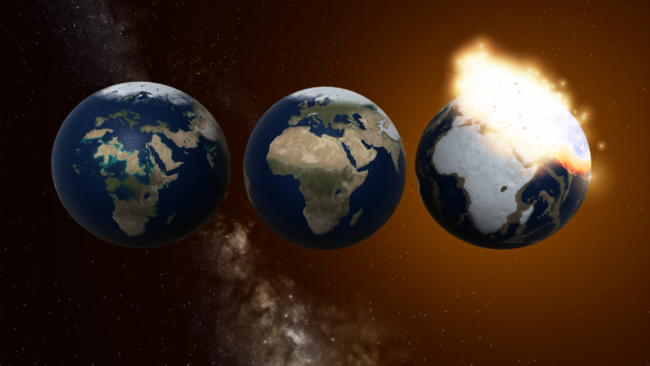
Run Steam to download Update 26.3, or buy Universe Sandbox via our website or the Steam Store.
Update 26.3
Drastically increased collision fragments and framerates, overhauled planetary water distribution, plus dozens of improvements come together in Update 26.3.
Oceans Filling Like a Bathtub
Water fills a tub from its lowest point – why not on a planet? Oceans now start at the lowest elevations and fill valleys like you would a bathtub, creating more realistic-looking continents and oceans. (Previously liquid water would “precipitate” evenly across the surface.)
Buttery Smooth Collisions & Particles Aplenty
Major performance improvements have resulted in epic collisions with double the particles. Fragment generation is substantially more consistent across various simulation speeds. Collisions now perform much more smoothly: in many cases, we’re seeing as much as triple framerate increases.
More Highlights
- Fixed the “annoying bug” that darkened customized planet surfaces
- Ice & Snow, which are simulated separately, now have color options
- Avast, Matey! Change an object’s Sea Level in the properties panel
- Cleaned up the object property panel and added new action buttons
Check out the full list of What’s New in Update 26.3
Please report any issues on our Steam forum, on Discord, or in-game via Home > Send Feedback.

Universe Sandbox Roadmap: 2020 & Beyond
Apr 30th

Universe Sandbox has improved significantly since our first Early Access release in 2015. We plan to add features and fix bugs for a long, long time to come (we even removed the “2” from our name for that reason). Here’s a look into what we have planned for 2020 and beyond.
What did we do in 2019?
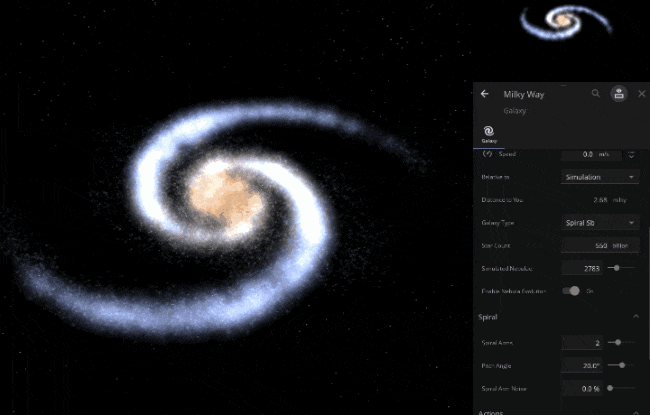
Last year saw 3 major feature releases (and a handful of minor, but still important, updates):
- Better Galaxies (Update 23)
- More stable and accurate galaxies and better collisions
- New and improved Introduction tutorial for helping new users
- Surface Grids & Lasers (Update 24)
- Surface Grids is a huge, complex feature that simulates the surfaces of planets, moons, and other objects
- Vaporize entire planets with the new Laser tool
- Custom Object Colors (Update 24.1)
- Customize colors for just about every object including planets, moons, stars, and black holes
- Dock graph windows alongside the other panels added with Surface Grids
View our “What’s New” for a chronological list of changes.
What’s the Plan for 2020?
The following list are all things we are working on currently. We’re aiming to deliver on all of this in 2020, but when they’ll be ready is difficult to predict, and priorities can change.
With its ability to simulate localized surface temperatures, water level, vapor content, and more, Surface Grids (Update 24) perfectly sets us up for a multitude of new features. Localized temperatures enabled us to create the mighty Galactic Empire Superlaser, but that’s only scratching the surface…
Surface Grids Improvements
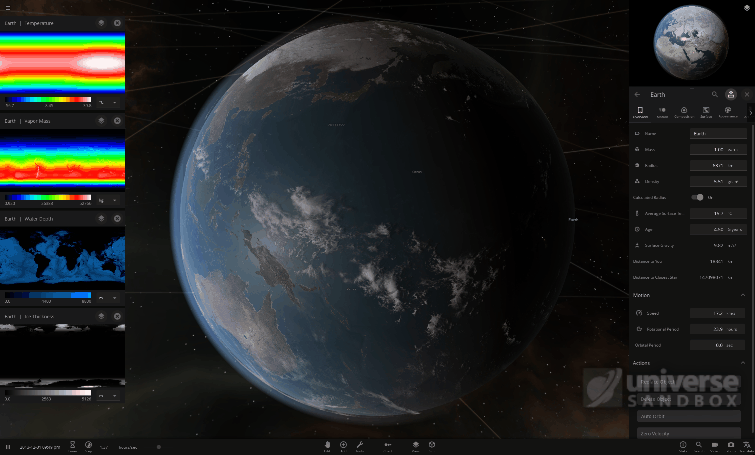
We’ve been saying that Surface Grids is the foundation for many things to come, so it only makes sense that we start the year off by further improving it.
- Improved Temperature & Atmosphere Simulation
- Surface Grids improvements started this year in January (Update 24.1.2), continued with Update 25 (March 2020), and will be a theme all year long
- Update 25 introduced a major rewrite to Tidal Heating and Vapor Flow calculations
- Better Performance & More Power
- Not only have we accomplished localized surface simulations on your everyday computer, but we continue to make performance improvements
- Shader Model 5.0, a graphics card technology, became a requirement in Update 25 because it will give us some legroom for current and future enhancements
- Detailed Surface Manipulation
- We are in the early stages of designing tools that allow for directly manipulating temperature, elevation, water level, vapor, and more on the surfaces of objects
- We plan to add the ability to view and edit the properties of individual surface grid “cells”. Take your planet customization and terraforming to a new heights with a level of precision you never thought possible
Material Composition System
Building off of the localized materials (water, CO2) in Surface Grids, we’re working to rebuild our material composition in a more robust way.
- Better System to Unify Materials
- Every point on the “grid” will better contain a mixture of various materials, in various material states
- Complicated calculations of, for example, when some liquids become heated to a gas, should be handled more efficiently in our new simulation code
- A Universe of Possibility
- Better terraforming, more realistic cloud and climate simulations, tidal waves, easy ways to manipulate the surface topography, and more detail on the surface view could all be the results of this new Material Composition System
- Who knows, maybe our planets could one-day support life?
Full Desktop User Experience in VR
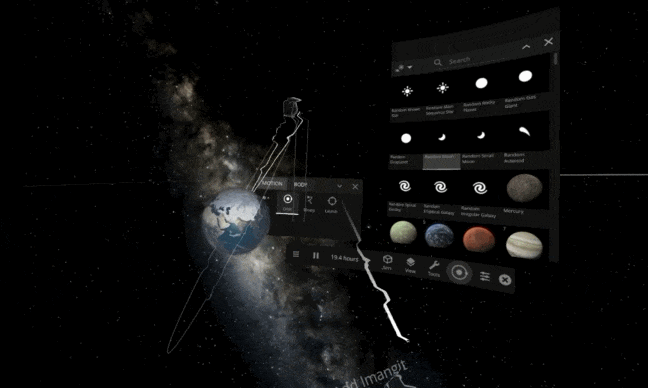
We have embraced a seemingly impossible goal of having a unified Universe Sandbox release no matter how you play. Whether you are on a powerful gaming PC, a laptop, a phone (coming soon), Virtual Reality, Mixed Reality, or a console (maybe soon? who knows!) the experience should be undiluted and awe-inspiring.
- A Magic Leap Forward
- With our recent Magic Leap 1 release, we were able to bring the full Desktop experience to the world of Mixed Reality
- Hard work pays off: the bulk of our Magic Leap 1 development helped unify our Mixed Reality, VR, and Desktop experience into one single vision
- Get Your Hands on it
- Enjoy Universe Sandbox in VR without limitations and with the full Desktop User Interface
- Grab planets with your hands, shoot lasers out of your fingertips, and watch galaxies collide as if you were really there, floating in space (but a bit less cold).
User Interface Improvements
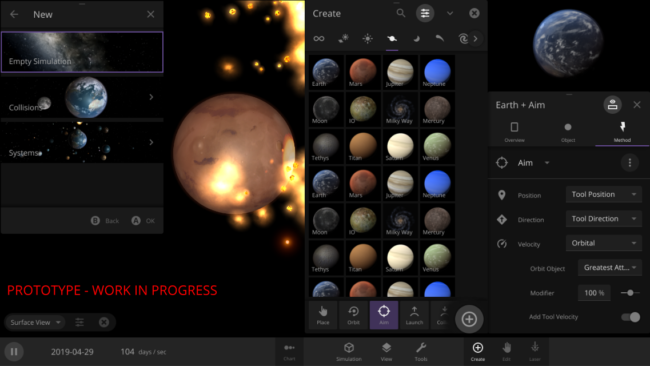
Creating the user interface (UI) for Universe Sandbox is a fun challenge. How do you give someone full control of the universe? As we add features and complexity to the simulation, keeping the UI accessible, discoverable, and easy to use becomes a constant challenge.
Over time, some portions of the interface can start to feel cluttered or outdated and are ready for a redesign. We’ve been working on some of these design changes for a long time, and it’s exciting to move closer to improving everyone’s experience with Universe Sandbox.
- Redesigned Bottom Bar
- Our current bottom bar has been collecting new buttons over the years without a cohesive vision for how it should all work. So we’ve rethought how everything should be organized and how we can make it work on really small screens.
- Improved Add Panel
- Like the Bottom Bar, the Add Panel is due for a makeover. We’re targeting a single shared UI for all platforms (desktop, touch, VR/AR, and consoles), so the new Add Panel is being built with that in mind.
…and beyond?
Mobile
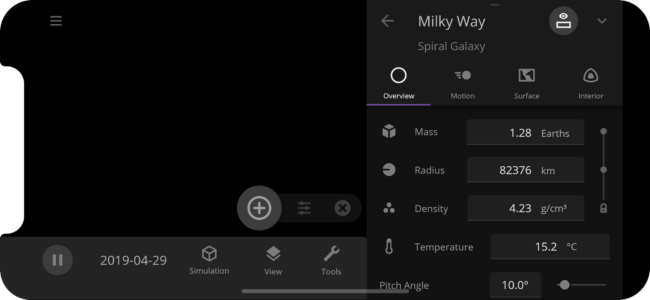
Enjoy Universe Sandbox on your phone or tablet! Sign up to get notified about our mobile version.
- Is that Universe Sandbox in Your Pocket?
- Our mobile version is in development right now for both Android and iOS. It’s no easy feat to simulate the universe on a smartphone, but we’re doing it!
- A Pure, Unadulterated Experience
- Some of the breakthroughs we made with both Surface Grids and Magic Leap have paid off and will allow for the full desktop version on your pocket-sized device
Life Simulation
Create the right conditions for life and watch it grow, or end it all with a major impact.
- Turn a cold, lifeless space rock into a vibrant planet
- Many details are still TBD, keep an eye out for a DevLog when we get started
Fluid Simulation

Smoothed-particle Hydrodynamics (SPH) will help create more detailed, realistic simulations of collisions, fragmentation, and formation of different types of objects. Read more in our SPH Fluid Simulation DevLog.
Experiments with Tools

This is firmly in the realm of experimentation at the moment, but we’re looking at new and interesting ways we can use our tools within a simulation. Driven by a need to automate testing of features, we’re working on ways to programmatically activate tools. By automating and attaching different tools to objects, we discovered that we can enable some pretty fun scenarios. The above clip is what happens when we attached a bunch of lasers to moons and tell it to automatically fire at the nearest object. Awesome stuff, right?
Gamepad Support… and more?
Do you want to sit back on your couch and play Universe Sandbox? So do we! We’ll be experimenting with full gamepad support. Who knows where that leads us, maybe even a console version in the future.
Hiring
We are currently hiring a Spaceship Physics Developer, join us!

Light It Up | Update 25.1
Apr 20th
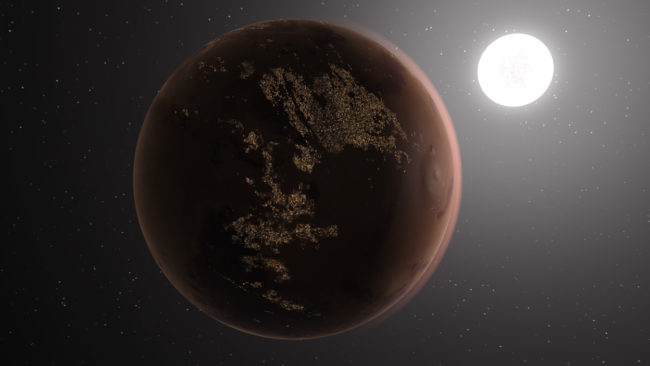
Run Steam to download Update 25, or buy Universe Sandbox via our website or the Steam Store.
Update 25.1 includes a host of bug fixes and lighting improvements, as well as a fun oft-requested feature to add customizable city lights to any rocky planet or large moon.
City Lights on Any Planet
You can now enable City Lights on any rocky planet or large moon by going to Object Properties > Appearance > City Lights. Select from Earth’s city map or a randomized procedural map, and define whether the lights will turn off if the surface is deemed uninhabitable.
Lighting Improvements
The interaction of multiple light sources has been reworked, particularly with how they reflect off an atmosphere.
General Fixes
We fixed a bunch of miscellaneous issues, including improving how supernova clouds impact objects, star temperature instability, orbit previews, shadows, and more.
Please report any issues on our forum, on Discord, or in-game via Home > Send Feedback.
I Like My Heat Tidal | Update 25
Mar 13th

Run Steam to download Update 25, or buy Universe Sandbox via our website or the Steam Store.
Update 25 brings significant improvements to our temperature and surface simulation, adding stability and accuracy, drastically improving speed, new object properties, and a rewrite to our tidal heating model. We’ve also added some often-requested features such as “Replace Object” and graph data export, as well as relocating save data associated with removing the “²” from “Universe Sandbox”.
Major Surface Simulation Performance Improvements
Moving from Shader Model 3 to 5, a feature of most modern graphics cards, allowed us to utilize new technology (compute shaders), lowering the video memory requirements of the surface simulation by almost half and increasing performance substantially. Moving forward, this will allow us to add additional complexity to surface grids, better collisions (using smoothed-particle hydrodynamics), and gorgeous graphical features. Because of this change, we have updated our minimum system requirements.
Temperature & Atmosphere Rewrite
Tidal heating and temperature calculations have just received a major rewrite. This includes significant improvements to vapor flow, atmosphere energy retention, and overall object energy absorption and radiation. You can see these properties in action in the new Energy Flow section in an object’s Surface tab, and in our new Energy and Heating guides.
Hot-swappable Celestial Object
A “Replace Object” button has been added to the Properties panel. This will allow you to hot-swap any object in the simulation for any other object, enabling a bunch of fun scenarios that were hard to do in the past.
The “²” is Silent
Just call us “Universe Sandbox”, we’ve gotten rid of the “²”. When loading the update for the first time, you may notice a “Migrating Data” message. We’re automatically reorganizing settings and saved files to reflect the name change.

Check out the full list of What’s New in Update 25
Universe Sandbox 2019 Retrospective
Feb 25th

While there’s a lot to look forward to in 2020, we’re going to take a moment to celebrate the milestones we reached this past year.
1
New team member.
Brendan is a graphics developer from Australia and is joining Georg in making everything in the universe beautiful, awesome, and graphically performant. He’s already worked on improving random planet generation, fixing black hole issues on the Magic Leap, and is now creating visuals for our experimental liquid planets project, AKA smoothed-particle hydrodynamics (SPH).
2
Number of full-time developers on a new platform.
Magic Leap 1! We started a new journey into augmented reality in 2019 and we’re really proud of the work we’ve done to bring the full power of Universe Sandbox to Magic Leap as an undiluted experience. Dave and Jacob focused most of the year on Magic Leap with support from the rest of the team.
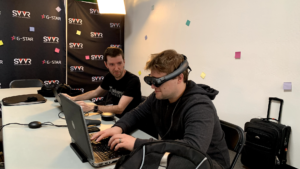
Universe Sandbox creator & director, Dan Dixon, working on Magic Leap with developer Dave Nelson.
4
New human-sized objects.
- banana
- watermelon
- sword
- sledgehammer
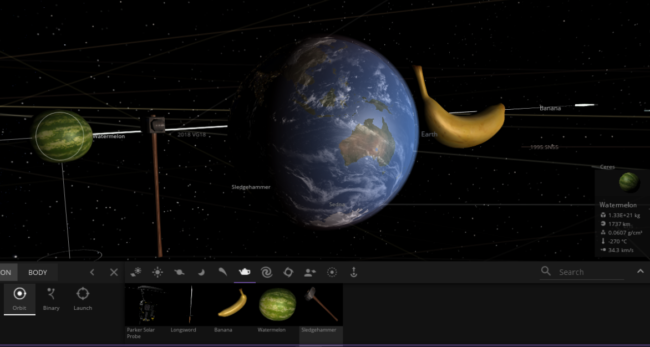
Everything you need to make a very bad fruit salad.
7
Significant updates to Universe Sandbox.
- Revamped Vapor & Engine Experiments | Update 22.2 | April 10, 2019
- A Big Day for Physics | Update 22.3 | May 30, 2019
- Beyond the Milky Way | Update 23 | June 25, 2019
- Galactic Clean-Up | Update 23.1 | August 20, 2019
- Saturn’s New Moons | Update 23.2 | November 01, 2019
- Surface Grids & Lasers | Update 24 | November 22, 2019
- The Color in Space | Update 24.1 | December 19, 2019
This year had a mix of improving existing content and rolling out new features. While there were fewer objects added, several key systems got revamped (see Surface Grids), setting the team up for exciting additions in the coming year.
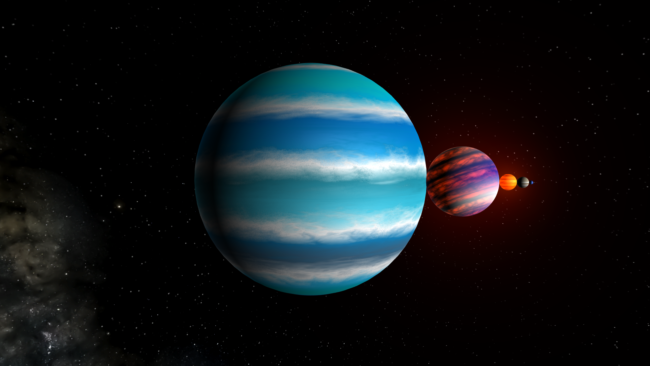
Image provided by Discord user Mangolia.
28
# of languages we now support, up from 22 last year.
A big thanks to our community for helping with our crowdsourced translation efforts! Want to help translate Universe Sandbox into your native language? Learn more.
| Bulgarian | Chinese Simplified | Chinese Traditional | Czech | Danish |
| Dutch | English | Filipino | Finnish | French |
| German | Greek | Hungarian | Indonesian | Italian |
| Japanese | Korean | Norwegian | Polish | Portuguese |
| Romanian | Russian | Spanish | Swedish | Thai |
| Turkish | Ukrainian | Vietnamese |
601
Highest number of concurrent users in Universe Sandbox in 2019.
This is higher than in 2018, and second only to our all-time high of 617 players in March of 2016, during our first big Steam sale.
1,963
# of users in our Discord server.
2,124
# of positive Steam reviews in 2019.
Seeing so much love for Universe Sandbox warms our hearts the way gravitational squishing heats Io.
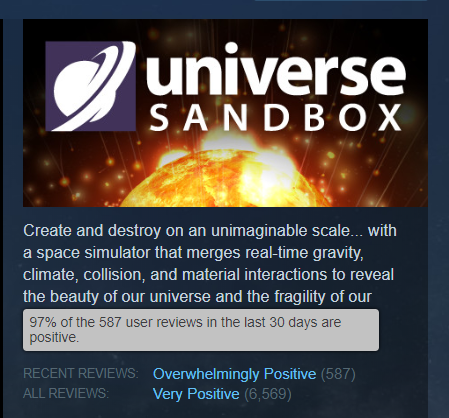
Overwhelmingly Positive reviews. Wow!
2403
# of code commits (changes) made to the Universe Sandbox project in 2019.

A look at our GitHub commits activity since 2015. The gray section shows 2019.
14,893
# of shared items in the Universe Sandbox Steam Workshop.
This is over six times as many as 2018! We can’t wait to see how this library of community creations grows in the coming year! To get through all of them in 2020, you’d have to check out slightly more than 40 per day. (Get cracking?)
103,541
# of messages sent on Slack (an instant messaging platform we use to communicate).
Giant Army is a completely remote team, with some dozen members on three continents. We also use Google Meet for our face to face video meetings but much of our work happens in text.
163,298
# of units sold on Steam.
In 2018, we sold a copy just about every five minutes. In 2019, that interval narrowed to a little under 3 minutes and 15 seconds.
474,811
Lasers equipped since our Surface Grids & Lasers release.
This is one of the stats we track using our built-in analytics.


The magic cold laser in action. Image provided by Discord user Anonymoose/BlueMarble.
8,093,789
# of views on most viewed Universe Sandbox video of the year.
We’ve been delighted to see GreyStillPlays make 26 videos featuring antics in Universe Sandbox.
10,485,760
# of individual data points we are simultaneously simulating on object surfaces.
This is our Surface Grid system, which is a foundation that we’ve been working on for years, and will enable us to skyrocket into the future with some pretty exciting features. More on that soon in the 2020 roadmap.
(with atlas resolution of 1024 × 2048 × 5 layers = 10,485,760 | higher-end computers can simulate 2048× 4096 × 5 layers = 41,943,040 points).
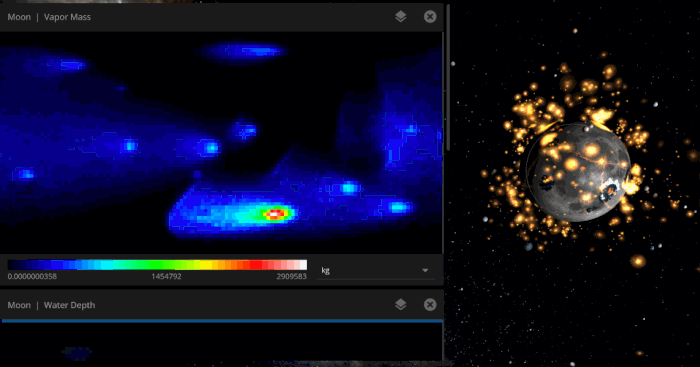
Vapor content on the Moon as it is bombarded by icy asteroids
What’s next?
Improvements to heat and material simulation across object surfaces, new tools, life simulation, better performance, data analysis, Magic Leap, a completely revamped VR experience, SPH – it’s hard to list it all. The foundational work we did in 2019 sets us up to do amazing things in the coming year.
Stay tuned for a 2020 roadmap, which we’ll publish next.
Thank you to everyone, to both new players and those who have been playing Universe Sandbox for years. Whether you’re analyzing orbits, creating fictional worlds, learning about astronomical material properties, or just having fun throwing planets together, we truly couldn’t do this without your continued enthusiasm for our little astronomy simulation. And we’re just getting started.
The Universe Sandbox Team
Dan, Chris, Georg, Alexander, Jonathan, Dave, Rappo, Mat, Jacob, Erika, and Brendan

